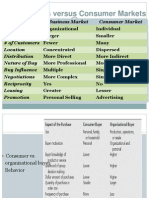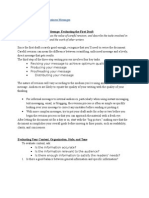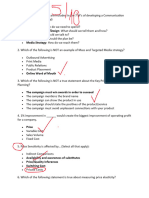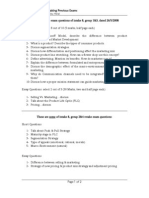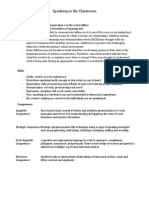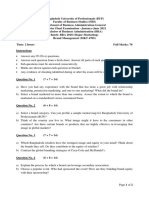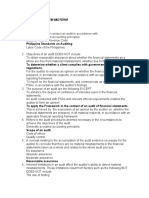0561-Marketing Theory & Practice
0561-Marketing Theory & Practice
Uploaded by
Muhammad NazirCopyright:
Available Formats
0561-Marketing Theory & Practice
0561-Marketing Theory & Practice
Uploaded by
Muhammad NazirCopyright
Available Formats
Share this document
Did you find this document useful?
Is this content inappropriate?
Copyright:
Available Formats
0561-Marketing Theory & Practice
0561-Marketing Theory & Practice
Uploaded by
Muhammad NazirCopyright:
Available Formats
ALLAMA IQBAL OPEN UNIVERSITY ISLAMABAD (Department of Business Administration)
*****
MARKETING THEORY & PRACTICE (561) CHECKLIST SEMESTER: SPRING 2010
This packet comprises the following material:1. 2. 3. 4. 5. Text Book Course Outlines Assignment No.1 and 2 Assignment forms (two sets) Tutorial Schedule
If you find anything missing, in this packet, out of the above mentioned material, please contact at the address given below: Deputy Registrar, Mailing Section, Block No. 28, Allama Iqbal Open University, H-8, Islamabad. Ph: 051-9057611-12 Muhammad Ayub Shaikh Course Coordinator
MARKETING THEORY & PRACTICE (Code No. 561)
Course title: Code No.: Level: Prerequisite: Credits: Marketing Theory & Practice 561 MBA Student should have qualified Bachelors Degree in any discipline and have good communication skills in English language. Half credit (A1OU System) = 3 credits in formal system
Introduction to the course Marketing helps organize the resources of an organization to meet the changing needs of customers on whom the organization depends. As a verb, marketing is all about how an organization addresses its markets. Marketing is more about a way of thinking than a series of prescriptive rules (Palmer, 2004). This course provides an introduction to the theory and practice of marketing beginning with the underlying theoretical bases which are often borrowed from the disciplines of economics, sociology, and psychology. The contents will cover concepts related to marketing planning, marketing information system, product development and management, pricing, distribution management and promotional strategies. Challenges presented by global marketing and developments in the information technology are also reflected in the course. The course will provide an opportunity to the students to relate marketing theory with practice. During the learning process students will be engaged in experiential learning and encouraged to use variety of sources to enrich their knowledge about the marketing discipline. Course objectives After completing this course the students should be able to: Define marketing and differentiate between marketing and selling Explain how to identify the target markets Describe the process of marketing mix Formulate marketing strategies Develop a plan for implementing marketing strategies Justify the need and importance of digital marketing Brief Outlines Unit 1 Introduction to Marketing Unit 2 Understanding and Targeting Customers Unit 3 Product, Branding, Packaging and Service Decisions Unit 4 Pricing Unit 5 Distribution Unit 6 Promotion Unit 7 Competition and Marketing Unit 8 Marketing Implementation Unit 9 Digital Marketing
ALLAMA IQBAL OPEN UNIVERSITY ISLAMABAD (Department of Business Administration)
***
WARNING
1.
2. PLAGIARISM OR HIRING OF GHOST WRITER(S) FOR SOLVING THE ASSIGNMENT(S) WILL DEBAR THE STUDENT FROM AWARD OF DEGREE/CERTIFICATE, IF FOUND AT ANY STAGE. SUBMITTING ASSIGNMENTS BORROWED OR STOLEN FROM OTHER(S) AS ONES OWN WILL BE PENALIZED AS DEFINED IN AIOU PLAGIARISM POLICY. To answer each question please pursue the following guidelines: Review the literature to develop your understanding about the question. Find the practical examples from authentic sources Build up arguments to support your answer Use Internet and Library sources to enrich your answers To maintain your academic integrity and honesty please integrate source material. There are basically three ways to integrate source material into your writing. You may o Quote it. o Paraphrase it. o Summarize it. Late assignments will not be entertained All questions carry equal marks.
Instructions: -
ASSIGNMENT No. 1
Course: Marketing Theory and Practice (561) Level: MBA Semester: Spring 2010 Marks: 100
Q. 1 Internal databases always give information about opportunities and problems help to plan marketing programs and evaluate performance, being a Marketing Manager of any Fast Moving Consuming Goods (FMCG), what information would you like to have in your internal database? How this information would be used? (20) Q. 2 (a) What is the difference between a product and service? How service marketing is different from product marketing? Also describe why marketing of services is difficult than marketing of goods. Answer with support of examples. (10) How companies can position their products for competitive advantage in the marketplace? Discuss. (10)
(b)
Q. 3 Examine product life cycle and answer the following questions? What stage you think is: (20) Most critical Most risky Most profitable Most negative Your answer must be based on logical arguments. Q. 4 Select three different products of your own choice and explain the factors (including demand, competition, costs, and other marketing mix) that have influenced its price? (20) Q. 5 Direct marketing is the practice of delivering promotional messages directly to potential customers on an individual bases. Obtain information from any commercial organization (such as Dawlance, Acer, and LG etc) and answer the following questions: (20) 1. What kind of direct marketing efforts they apply? 2. How do they make it easy to order their product? 3. How are their products different from competitors? 4. What are their competitive advantages and disadvantages?
ASSIGNMENT No. 2
This assignment is a research activity. You are required to visit any business/commercial organization and study their marketing system as whole or marketing of product and prepare a research report of about 15 to 20 pages on one of the topics given below. To avoid the duplication a student is required to select the topic according to the last digit of his/her role number. For example if your roll number is I-3427121 then you will select topic # 1 from the list (last digit) given below: As there are four topics, you will select the topics according to the last digit mentioned as under: 1 2 3 Topics Last digit of the role number 1, 2, 3 4, 5 6, 7 8, 9, 0 Topics 1. 2. 3. 4. Developing and Implementing Product Strategies Developing and Implementing Pricing Strategies Developing and Implementing Distribution Strategies Developing and Implementing Promotion Strategies
The assignment should be developed on the following format. Introduction 10 marks Review of literature 30 marks The data collection method 10 marks Data analysis 20 marks Conclusions and recommendations 20 marks References 10 marks Annexes Guidelines for the submission of assignments You are required to prepare two copies of 2nd assignment. Submit one copy to your tutor/ teacher for evaluation and the second copy for presentations in the workshop in the presence of the resource person and classmates, which will be held at the end of the semester prior to the final examination. Guidelines for workshop The workshop is a compulsory component of this course to cover practical aspects of the curriculum, which will be held at the end of the semester and your attendance is compulsory in all sessions. There are two components in the workshop. The first part is a group activity. The students will be divided into four groups and they would be assigned topics as under: Group one: Developing and Implementing Product Strategies Group two: Developing and Implementing Pricing Strategies Group three: Developing and Implementing Distribution Strategies Group four: Developing and Implementing Promotion Strategies Each group will select a group leader and discuss the topic within the group. The group members will act as members of the top management team of a company and discuss aspects of management by using models and theories covered in the course. The focus of the group activity would be on theories, models, case studies and practical examples of real life situation of national and international industries, business organizations, and products. The group discussion will enable students to share their knowledge and experiences. This will also help them in getting clarity of the concepts and discuss the issues faced by the management of different organizations observed and studied by the group members. You will come with full preparation and this activity will be supervised by one of the resource persons, who will act as facilitators. All groups will work simultaneously and complete this task on the first day of the workshop. The group will prepare a presentation based on the findings of the discussion. If you do not participate in this activity you will be declared absent from workshop and will have to attend the workshop in the next semester or act according to the university rules.
On the second day each group will perform that said activity and other groups will participate as observers. The tutor will write a report on the strengths and weaknesses of each group member and will evaluate each student. The tutors/teacher will keep record of his observations and submit the same to the RD who would send it to the Quality Assurance Cell, Department of Business Administration, Allama Iqbal Open University, Sector H-8 Islamabad, within one week of the evaluation by the tutor. The 2nd component of the workshop is an individual activity. The guidelines for this activity are as under: Each student will present his/her 2nd assignment in the workshop. You are advised to prepare the presentations based on your second assignment. Each student will be given 10 minutes for presentation and 5 minutes for class discussion. The participants and tutor/teacher will allow the presenter to make his/her presentation for 10 minutes to provide him/her an opportunity to gain confidence and improve his/her communication skills. The questions to generate the discussion and evaluate the performance will be asked in the last five minutes. To maintain the discipline and for effective time management each student is required to make presentation according to the last digit of his/ her roll number. For example if your roll number is I-342701 then you will be the first presenter (last digit). Fifty percent marks will be assigned to group activity and the remaining fifty percent to the individual presentation. The resource person/ teacher/ tutor (academic in charge of the workshop) will write a two page report about the workshop activity as a whole and send it on the following address along with individual report about each student's performance in the group activity for quality assurance.
MARKETING THEORY & PRACTICE Course Outline (MBA-561)
Unit 1 Introduction to Marketing 1.1 The field of marketing 1.1.1 The marketing concept 1.1.2 The scope of marketing 1.1.3 Philosophical foundations of marketing 1.1.4 Limitations of the marketing concept 1.1.5 Marketing process 1.1.6 Marketing challenges 1.2 The marketing environment 1.2.1 Macro environment of the company 1.2.2 Micro environment of the company 1.2.3 An organization's internal environment 1.2.4 Environmental scanning 1.3 Planning marketing 1.3.1 Nature and scope of planning 1.3.2 Process of market planning 1.3.3 Strategic company planning and marketing planning 1.4 Marketing ethics and corporate social responsibility 1.4.1 Criticisms of marketing 1.4.2 Responses to criticisms 1.4.3 A Societal orientation in marketing Understanding and Targeting Customers 2.1 Consumer markets and consumer buying behavior 2.1.1 Dimensions of buyer behaviour 2.1.2 Influences on consumer behavior 2.1.3 The buyer decision-making process 2.1.4 Types of buying-decision behaviour 2.2 Business markets and business buyer behavior 2.2.1 Types of business markets 2.2.2 Dimensions of business buyer behavior 2.2.3 Influences on business buyers 2.2.4 Business buying process 2.2.5 Institutional and government markets 2.3 Segmenting markets, targeting and positioning 2.3.1 Market segmentation and its role in developing marketing strategy 2.3.1.1 Defining markets 2.3.1.2 Why segment markets? 2.3.1.3 Criteria for effective segmentation 2.3.1.4 Bases for segmenting consumer and business markets 2.3.1.5 Evaluating market segments
Unit 2
2.4
2.3.2 Targeting strategies 2.3.3 Positioning strategies Marketing research and information systems 2.4.1 Importance of marketing research 2.4.2 Approaches to conducting marketing research 2.4.3 Marketing research process 2.4.4 Role of marketing information systems 2.4.5 Components of marketing information system
Unit 3
Product, Branding, Packaging and Service Decisions 3.1 Product planning and development 3.1.1 Defining a product 3.1.2 Classification of goods 3.1.3 Importance of product innovation and development of new products 3.1.4 Organizing for product innovation 3.1.5 New product development process 3.1.6 Customer adoption process 3.1.7 Strategic issues in expending the product range 3.2 Product-Mix strategies 3.2.1 Product line and product mix 3.2.2 Product-mix strategies 3.2.3 The concept of product life cycle 3.2.4 Planned obsolescence and fashion 3.3 Brands, packaging and other product features 3.3.1 The benefits of brands 3.3.2 Brand strategies 3.3.3 Buying versus building brands 3.3.4 Valuing brands 3.3.5 Packaging and labeling 3.3.6 Other image-building features 3.4 Services marketing 3.4.1 Nature and importance of services 3.4.2 Classifying services 3.4.3 Marketing mix for services 3.4.4 Marketing in non-profit organization Pricing 4.1 Pricing objectives and price determination 4.1.1 Nature and importance of price 4.1.2 Pricing objectives 4.1.3 Factors influencing price determination 4.1.4 Assessing price competitiveness 4.2 Product life cycle pricing 4.3 Psychological pricing
Unit 4
4.4
4.5 4.6
Pricing models 4.4.1 Market-based pricing model 4.4.2 The cost plus pricing model 4.4.3 The value-based pricing model Pricing strategy and break-even analysis Pricing strategy decisions 4.6.1 Discounts and allowances 4.6.2 Geographic pricing strategies 4.6.3 One price versus flexible prices strategy 4.6.4 Skimming and penetration pricing 4.6.5 Price and non-price competition 4.6.6 Pricing for business buyers
Unit 5
Distribution 5.1 Retailing 5.1.1 Role of intermediaries in a value chain 5.1.2 Nature of retailing 5.1.3 Retail locations 5.1.4 Classification of retailers 5.1.5 Issues and trends in retailing 5.2 Franchising 5.2.1 Types of retail franchise 5.2.2 Advantages and disadvantages of franchising 5.2.3 Trends in franchising 5.3 Wholesaling 5.3.1 Nature and importance of wholesaling 5.3.2 Types of wholesalers 5.3.3 Facilitating agencies 5.3.4 Trends in wholesaling 5.4 Channels of distribution 5.4.1 Types of distribution channels 5.4.2 Selecting a channel of distribution 5.4.3 Conflict and cooperation in distribution channel 5.4.4 Legal issues in channel management 5.5 Management of physical distribution 5.5.1 Nature and importance of physical distribution management 5.5.2 The strategic use of physical distribution 5.5.3 Major tasks in physical distribution management 5.5.4 Ethical issues in distribution Promotion 6.1 The promotional programme 6.1.1 Meaning and importance of promotion 6.1.2 The communication process 6.1.3 Determination of promotional mix 6.1.4 Setting the total promotional budget
Unit 6
6.2
6.3
6.4
Managing personal selling 6.2.1 Forces affecting sales 6.2.2 Types of selling 6.2.3 Nature and importance of personal selling 6.2.4 Personal selling skills 6.2.5 S ales management 6.2.6 Evaluating a sales person's performance Direct marketing 6.3.1 Defining direct marketing 6.3.2 Reasons of growth in direct marketing activity 6.3.3 Direct marketing tools 6.3.4 The direct marketing process 6.3.5 Nature and uses of database marketing 6.3.6 Customer relationship management 6.3.7 Media decision 6.3.8 Ethical issues in direct marketing Managing advertising and sales promotion 6.4.1 Nature and objectives of advertising 6.4.2 Developing an advertising campaign 6.4.3 Evaluating the advertising efforts 6.4.4 Organizing for advertising 6.4.5 Sales promotion 6.4.6 Publicity and public relations
Unit 7
Competition and Marketing 7.1 Competitive forces in the market place 7.2 Competitors and competitive advantage 7.2.1 Analyzing competitive industry structure 7.2.2 Competitor analysis 7.2.3 Competitive advantage 7.2.4 Creating a differential advantage 7.2.5 Creating cost leadership 7.3 Developing competitive marketing strategy 7.4 The nature of competitive behaviour 7.5 Developing competitive marketing strategies 7.5.1 Build strategy 7.5.2 Hold strategy 7.5.3 Niche strategy 7.5.4 Harvest strategy 7.5.5 Divest strategy Marketing Implementation 8.1 Implementation of marketing strategy and performance evaluation 8.1.1 Internal marketing 8.1.2 Developing implementation strategies
Unit 8
10
8.2 8.3
8.4
8.1.3 Evaluating marketing performance 8.1.4 Barriers to the implementation of the marketing concept Marketing organization Marketing control 8.3.1 Principles of control 8.3.2 Strategic control 8.3.3 Operational control 8.3.4 Benchmarking International marketing 8.4.1 Domestic marketing and international marketing 8.4.2 Deciding whether to go international 8.4.3 Deciding which markets to enter 8.4.4 Deciding how to enter a foreign market 8.4.5 Developing international marketing strategy 8.4.6 Organizing for international operations
Unit 9
Digital Marketing 9.1 Defining digital marketing 9.2 Elements of the digital age 9.3 Digital marketing and the traditional marketing mix 9.4 Digital marketing planning 9.5 Digital marketing media 9.6 Organizational competences for digital success 9.7 E-Commerce domains 9.8 Conducting E-Commerce 9.9 Challenges of E-Commerce 9.10 Ethical issues in digital marketing
Recommended Text Book Kotler, Philip and Armstrong, Gary (2005) Principle of Marketing, 11th Ed., Upper Saddle River, NJ: Pearson/Prentice Hall. Additional Readings William J. Stanton, Charles Futrell Fundamentals of Marketing, latest Ed. Jobber, David (2007) Principles and practice of marketing, 5th Ed., Maidenhead: McGraw-Hill Education Ranchhod, Ashok (2007) Marketing Strategies, Financial Times Prentice Hall Baker, M. J. (2006) Marketing: an introductory text, Helensburgh: WP Jeromme E. McCarthy, William D. Perreault Jr. Basic Marketing, latest Ed. =======
11
You might also like
- (PDF Download) Managing Innovation: Integrating Technological, Market and Organizational Change 7th Edition Tidd Fulll ChapterDocument64 pages(PDF Download) Managing Innovation: Integrating Technological, Market and Organizational Change 7th Edition Tidd Fulll Chapterbochudemerry100% (3)
- Island Video Productions QuestionsDocument2 pagesIsland Video Productions QuestionsJasmine ActaNo ratings yet
- Individual Assignment SAP HWDocument11 pagesIndividual Assignment SAP HWJay MehtaNo ratings yet
- Business Versus Consumer MarketsDocument24 pagesBusiness Versus Consumer MarketssrikapoorNo ratings yet
- Book Review - Assignment JaffnaDocument4 pagesBook Review - Assignment JaffnaNaveen Sharma0% (1)
- Google Presentation EditedDocument9 pagesGoogle Presentation Editedsanskriti goelNo ratings yet
- A BookDocument5 pagesA BookAlrid FullerNo ratings yet
- Leveraging Your CommunicationsDocument35 pagesLeveraging Your Communicationsshush10No ratings yet
- Role Play Judging Criteria 2010Document3 pagesRole Play Judging Criteria 2010Sachiko YosoresNo ratings yet
- 2021 QTI MGT489 Course OutlineDocument5 pages2021 QTI MGT489 Course OutlineNahida akter jannat 1712024630No ratings yet
- Chapter 6 Completing Business MessagesDocument19 pagesChapter 6 Completing Business MessagesVikki Denise Mclawhorn-Fox100% (1)
- MKTG 392-Brand Management-Sarah Suneel SarfrazDocument8 pagesMKTG 392-Brand Management-Sarah Suneel SarfrazAbdullahIsmailNo ratings yet
- Book Review: The Knowing Organization - Chun Wei ChooDocument20 pagesBook Review: The Knowing Organization - Chun Wei Choofloor.scheffer479No ratings yet
- Book Review AssignmentDocument2 pagesBook Review Assignmentobhanushali296No ratings yet
- Book Review How ToDocument12 pagesBook Review How ToEwata ThompsonNo ratings yet
- Advanced MarketingDocument31 pagesAdvanced MarketingHaizea de Diego EsparzaNo ratings yet
- Strategy and MarketingDocument69 pagesStrategy and MarketingCao ChanNo ratings yet
- Digital Marketing SyllabusDocument11 pagesDigital Marketing SyllabusSaradhi GonelaNo ratings yet
- Customer Insights, Brand Awareness, Sales & Distribution: Summer Internship ProjectDocument21 pagesCustomer Insights, Brand Awareness, Sales & Distribution: Summer Internship ProjectRam JainNo ratings yet
- New Retail Segmentation v2 - Indonesia - 2015 - Understand Your Retailer PDFDocument89 pagesNew Retail Segmentation v2 - Indonesia - 2015 - Understand Your Retailer PDFSteven CavéllNo ratings yet
- MarketingDocument19 pagesMarketingHaziNo ratings yet
- Group Discussion Topics ListDocument1 pageGroup Discussion Topics ListRonaky123456No ratings yet
- Principles and Practice of Management Group AssignmentDocument1 pagePrinciples and Practice of Management Group AssignmentJo Bryan0% (1)
- Bovee bct15 PPT 06-FinalDocument31 pagesBovee bct15 PPT 06-Finallogeswarysanmugam66No ratings yet
- Webquest IdiomsDocument15 pagesWebquest IdiomsElenaAlcamesiNo ratings yet
- Chapter 7 Positive, Neutral, and Social Business MessagesDocument10 pagesChapter 7 Positive, Neutral, and Social Business Messagesvj1234567100% (1)
- Final Assignment of Business ManagementDocument12 pagesFinal Assignment of Business ManagementMuhammad IshfaqNo ratings yet
- 2 - 4 PowerPoint Do's & Don'tsDocument4 pages2 - 4 PowerPoint Do's & Don'tskaziba stephenNo ratings yet
- Business Letters The Writing Center PDFDocument8 pagesBusiness Letters The Writing Center PDFThiha NaungNaungNo ratings yet
- Syllabus BA311 TuesdayDocument6 pagesSyllabus BA311 TuesdayMilo MinderbenderNo ratings yet
- KunalJain - Dr. S Senthil KumarDocument37 pagesKunalJain - Dr. S Senthil KumarShubham Tiwari0% (1)
- The Ladder of LoyaltyDocument7 pagesThe Ladder of Loyaltyguru110100% (1)
- Ted Talk Speech Peer EvaluationDocument1 pageTed Talk Speech Peer EvaluationEmily ScottNo ratings yet
- Dmba102 Business Communication Sep 2023Document4 pagesDmba102 Business Communication Sep 2023phani.dubaiNo ratings yet
- Marketing Exams SummaryDocument2 pagesMarketing Exams SummarynataashNo ratings yet
- Capstone Project Mba Research Project Guidelines ManualDocument17 pagesCapstone Project Mba Research Project Guidelines ManualSK JadoonNo ratings yet
- Scoring GuidelineDocument1 pageScoring GuidelineLuthfanNo ratings yet
- Customer Experience Management in Retailing Understanding The Buying ProcessDocument16 pagesCustomer Experience Management in Retailing Understanding The Buying ProcessAlice Uchoa100% (9)
- Cuegis Essay 2Document2 pagesCuegis Essay 2Martha PrawiradirdjaNo ratings yet
- Consumer Behaviour ExercisesDocument2 pagesConsumer Behaviour ExercisesVignesh ParthasarathyNo ratings yet
- Speaking HandoutDocument5 pagesSpeaking Handoutapi-183214315No ratings yet
- ILM Level 5 Qualifications in Management 0310Document2 pagesILM Level 5 Qualifications in Management 0310Khalid MkmNo ratings yet
- Conceptualizing, Measuring, and Managing Customer Based Brand Equity (Keller)Document23 pagesConceptualizing, Measuring, and Managing Customer Based Brand Equity (Keller)Sayed Shaiq Ali MusaviNo ratings yet
- Integrated Marketing Communication PlanDocument5 pagesIntegrated Marketing Communication Planprojectwork185No ratings yet
- NITIE Mumbai - Business and Operations Analytics 2021 - Quiz 2Document12 pagesNITIE Mumbai - Business and Operations Analytics 2021 - Quiz 2kamal ji tiwariNo ratings yet
- Submitted To: AssignmentDocument11 pagesSubmitted To: AssignmentMeskat Hassan KHanNo ratings yet
- Brand Management (MKT4705)Document2 pagesBrand Management (MKT4705)Sayeed RahmanNo ratings yet
- "Principles of Finance"How To Money Market and Capital Market Work in The Economy of Bangladesh"Document24 pages"Principles of Finance"How To Money Market and Capital Market Work in The Economy of Bangladesh"Sheikh Md SiyamNo ratings yet
- DDocument6 pagesDTesfaye Belaye50% (2)
- Chapter 4 - Creating Customer Value - Satisfaction and Loyalty - W QDocument24 pagesChapter 4 - Creating Customer Value - Satisfaction and Loyalty - W QH. V.No ratings yet
- Fall 2015 Project Guidelines (MGT 201)Document2 pagesFall 2015 Project Guidelines (MGT 201)Harish KhatriNo ratings yet
- Business Comunication BUCODocument220 pagesBusiness Comunication BUCOvijayabaskaran PalanisamyNo ratings yet
- 01 - Professional Communication in Today's Digital, Social, Mobile WorldDocument59 pages01 - Professional Communication in Today's Digital, Social, Mobile WorldNur AinNo ratings yet
- Effective Presentation Skills-Chapter 1-PrintedDocument29 pagesEffective Presentation Skills-Chapter 1-PrintedEzatullahNo ratings yet
- Proctor & Gamble Using Marketing Research To Build BrandsDocument7 pagesProctor & Gamble Using Marketing Research To Build BrandsMd. AsifNo ratings yet
- Group Assignment 1 2014 CBDocument2 pagesGroup Assignment 1 2014 CBDidaLioniesaSusiloNo ratings yet
- Work Book Resume ExercisesDocument20 pagesWork Book Resume ExercisesAbhishek SharmaNo ratings yet
- Skills in ReadingDocument15 pagesSkills in ReadingRara Rahman PutriNo ratings yet
- Chapter 9: Strategic ManagementDocument3 pagesChapter 9: Strategic ManagementAnay Gloriana100% (1)
- PV RatioDocument2 pagesPV RatioVeeraraghulNo ratings yet
- SABV Topic 2 QuestionsDocument3 pagesSABV Topic 2 QuestionsNgoc Hoang Ngan NgoNo ratings yet
- Literarture ReviewDocument10 pagesLiterarture ReviewDostar ChuNo ratings yet
- PRINCIPLES OF MARKETING Module 1Document3 pagesPRINCIPLES OF MARKETING Module 1lycosexcellence22No ratings yet
- 22entrepreneurial Attitude and Business Orientation of Jimma UDocument24 pages22entrepreneurial Attitude and Business Orientation of Jimma UTemesgenNo ratings yet
- Introduction To Big BazaarDocument24 pagesIntroduction To Big BazaarRockyLagishettyNo ratings yet
- Weekly Business Update - Business Development - 032519-032919Document26 pagesWeekly Business Update - Business Development - 032519-032919Nate TrinityNo ratings yet
- Chapter 21Document9 pagesChapter 21Christian Blanza LlevaNo ratings yet
- Turning Customer Information Into Sales KnowledgeDocument1 pageTurning Customer Information Into Sales KnowledgeHEM BANSALNo ratings yet
- Unidad 1 - Fase 1 - Reconocimiento Del Curso - Nancy Vargas - 102026 - 91Document10 pagesUnidad 1 - Fase 1 - Reconocimiento Del Curso - Nancy Vargas - 102026 - 91Nancy VargasNo ratings yet
- Jss 1 BusinessDocument1 pageJss 1 Businessbeckyabm16No ratings yet
- 14W-Ch 16 Capital Structure Decisions - BasicsDocument31 pages14W-Ch 16 Capital Structure Decisions - BasicsMuhammadHammadNo ratings yet
- Domestic-Fan-Industry ProjectDocument21 pagesDomestic-Fan-Industry ProjectRajib RhdNo ratings yet
- Aacap1 2021-2022 Midterm ExaminationDocument18 pagesAacap1 2021-2022 Midterm Examinationsharielles /No ratings yet
- Shivalik Bank - Annual Report 2022-23 (25th Sep 2023)Document83 pagesShivalik Bank - Annual Report 2022-23 (25th Sep 2023)anilkumarak9532No ratings yet
- PM QuestionsDocument6 pagesPM QuestionsFacts FactsNo ratings yet
- BoLinkedObject EnumerationDocument3 pagesBoLinkedObject EnumerationaruntbNo ratings yet
- Customer Relationship Management Strategies of PNB and Dena BanksDocument17 pagesCustomer Relationship Management Strategies of PNB and Dena BanksRohit Semlani100% (1)
- Amatullah ResumeDocument1 pageAmatullah ResumeAmatullah LightwalaNo ratings yet
- Developing A Business Plan. Case Simon's Smoothies: Simonson, ConnorDocument56 pagesDeveloping A Business Plan. Case Simon's Smoothies: Simonson, ConnorNurun NabiNo ratings yet
- JPIA Review S2 - Cost Accounting and ControlDocument29 pagesJPIA Review S2 - Cost Accounting and ControlrylNo ratings yet
- 1-7 Statement of Cash Flow - Indirect MethodDocument22 pages1-7 Statement of Cash Flow - Indirect MethodHazel Joy DemaganteNo ratings yet
- 2013 THE IMPACT OF BRAND COMMUNICATION ON BRAND EQUITY DIMENSIONS AND BRAND PURCHASE INTENTION THROUGH FACEBOOK-with-cover-page-v2Document21 pages2013 THE IMPACT OF BRAND COMMUNICATION ON BRAND EQUITY DIMENSIONS AND BRAND PURCHASE INTENTION THROUGH FACEBOOK-with-cover-page-v2Sebastian Iosub100% (1)
- Background of ZaraDocument7 pagesBackground of ZaraMahatab OniNo ratings yet
- 2 Capacity PlanningDocument64 pages2 Capacity PlanningAbbas KarmaliNo ratings yet
- Digital Marketer Referent - Decathlon HKDocument4 pagesDigital Marketer Referent - Decathlon HKClaire VandebeulqueNo ratings yet
- International Operations ManagementDocument10 pagesInternational Operations ManagementKolin OtaruNo ratings yet
- S2 2021 437081 BibliographyDocument3 pagesS2 2021 437081 BibliographyALBERTUS NONO SUTRISNONo ratings yet



